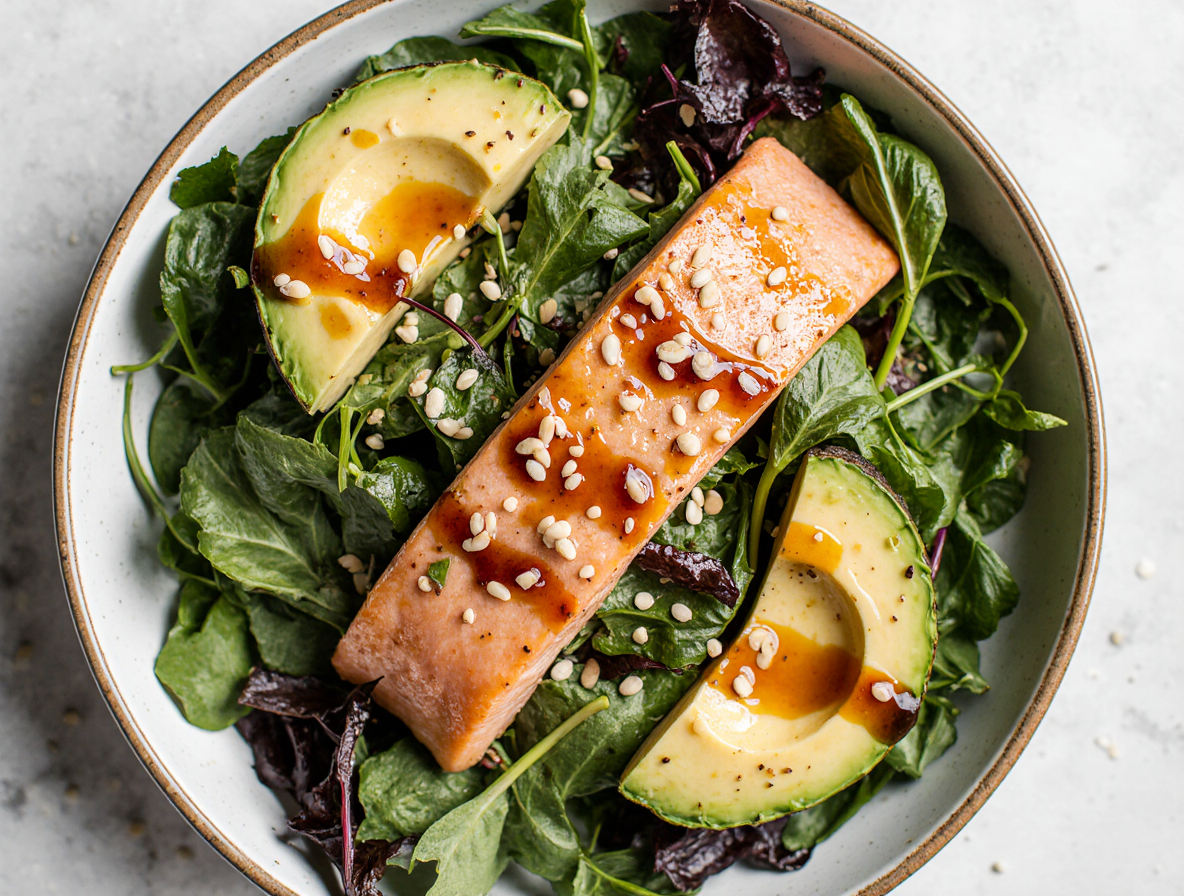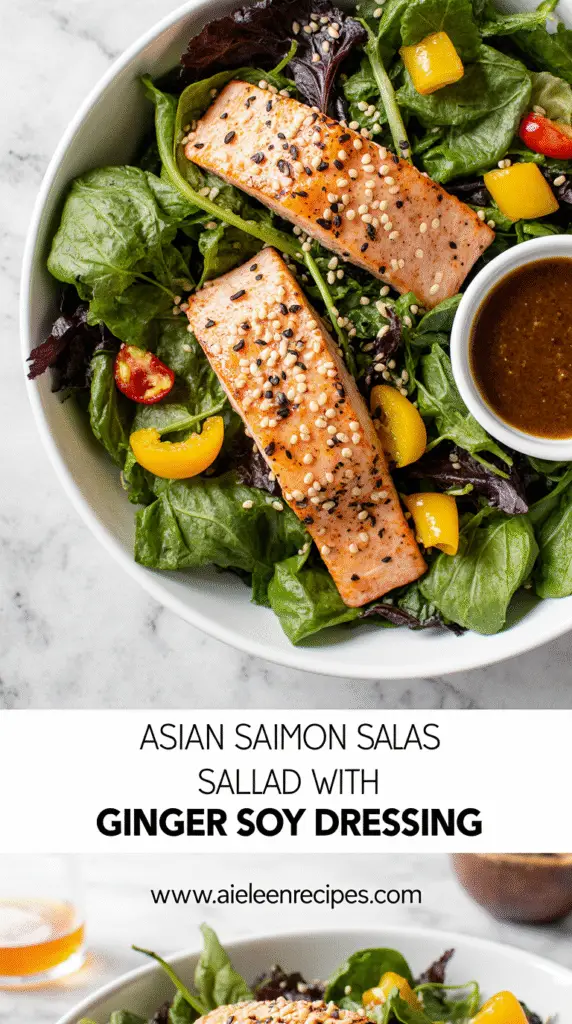How to Make Asian Salmon Salad: A Chef’s Secret Recipe Guide
Did you know that Asian salmon salad packs a powerful nutritional punch with up to 35g of protein and over 40% of your daily vitamin C requirements in a single serving?
Surprisingly, this isn’t just another healthy meal option. Asian salad with salmon combines the perfect balance of flavors – from the rich teriyaki salmon salad glaze to the bright, tangy sesame ginger salmon salad dressing. What makes this dish stand out is how Asian dressings typically have a lower ratio of oil to vinegar compared to Western dressings, creating that distinctive flavor profile we all love in an Asian salmon salad recipe.
This vibrant dish is essentially made up of three key components: perfectly glazed salmon, a light citrus soy dressing, and a colorful mix of fruits and vegetables. Each element plays a crucial role in creating a meal that’s both satisfying and nutritionally complete, with some versions providing up to 616 calories per serving.
In this guide, I’ll walk you through my chef-tested techniques for creating the ultimate Asian salmon salad. From selecting the perfect salmon filets to balancing flavors in your dressing and assembling a restaurant-worthy presentation, you’ll discover why this dish is great for entertaining all year round. Let’s dive into this delicious culinary adventure together!
Choosing and Preparing the Salmon
The foundation of a perfect Asian salmon salad begins with selecting quality salmon filets. Properly prepared salmon not only elevates the dish’s flavor but also enhances its nutritional profile.
How to select the best salmon filets
The key to an exceptional Asian salmon salad lies in choosing salmon with vibrant color and plump, moist flesh. When shopping, look for filets that spring back when gently pressed. For wild salmon, check that the eyes are clear and shiny if buying a whole fish. Furthermore, always smell the salmon before purchasing—it should smell fresh, not fishy.
Wild-caught salmon generally offers a richer, more robust flavor and firmer texture compared to farmed varieties. In particular, many chefs consider King (Chinook) salmon the pinnacle of flavor due to its buttery texture and high-fat content. Nevertheless, Sockeye salmon, with its deep red color and bold taste, makes an excellent alternative for Asian salmon salad recipes.
Marinating tips for deeper flavor
For an authentic Asian salmon salad, marinating is essential. A mixture of soy sauce, ginger, rice vinegar, and a touch of honey creates an ideal base for marination. For individual salmon filets, marinate for 30 minutes to 1 hour. However, if using a larger whole filet, you can extend this time up to 2 hours.
One chef-approved technique involves marinating salmon in a salty, acidic solution before cooking. Specifically, a mixture of orange juice with a teaspoon of sea salt for 10-20 minutes not only enhances moisture retention but also reduces the formation of carcinogens when grilling by up to 80%.
For Asian salmon salad dressing, reserve some of the marinade before adding the salmon—this creates harmony between the fish and salad flavors.
Pan-searing vs. baking: which is better?
Both methods have their merits for teriyaki salmon salad. Pan-searing creates a delicious caramelized exterior and cooks quickly. Indeed, when pan-searing salmon cubes, they cook in just 2-3 minutes, providing maximum surface area for glaze caramelization.
In contrast, baking offers convenience with minimal cleanup. For a 1-inch thick filet, baking typically takes 10-12 minutes in a 400°F oven. This method distributes heat evenly, helping the outside get crispy while keeping the inside tender.
For sesame ginger salmon salad, either method works well. If you prefer crispy skin, pan-searing is ideal; if you’re cooking larger filets or meal prepping, baking might be more practical.
Making the Asian Salmon Salad Dressing
The secret sauce that makes an asian salmon salad truly exceptional lies in its dressing. Creating a balanced, flavorful dressing transforms ordinary ingredients into a memorable culinary experience.
Ginger soy vs. sesame ginger: flavor profiles
Ginger soy dressing primarily offers a bright, tangy profile with umami undertones. This style typically combines fresh ginger, garlic, soy sauce, rice wine vinegar, and a touch of honey or agave for balance. The result is a lighter, more translucent dressing that complements rather than overwhelms the salmon.
Conversely, sesame ginger dressing delivers a nuttier, richer experience. The addition of toasted sesame oil creates distinctive depth and aroma. Some recipes incorporate nut butters like almond or SunButter for creaminess and thickening. This style pairs exceptionally well with heartier salmon preparations in sesame ginger salmon salad recipes.
How to balance sweet, salty, and tangy
Achieving perfect balance remains crucial for any asian salmon salad dressing. Most chefs recommend a 1:1 oil-to-acid ratio for maximum flavor – significantly less oil than traditional Western dressings. For sweetness, honey and maple syrup are interchangeable, with brown sugar working effectively in a pinch.
For acidity, rice vinegar serves as the foundation, occasionally supplemented with fresh lime or orange juice. The umami component comes from soy sauce or coconut aminos (for gluten-free options). Finally, sesame oil should be added carefully – its potent flavor can quickly dominate.
Make-ahead tips for the dressing
Fortunately, asian salmon salad dressing improves with time as flavors meld together. Most recipes store beautifully in refrigerated airtight containers for up to one week. For longer storage (up to two weeks), omit fresh ingredients like garlic, ginger, or herbs until serving time.
Before serving, simply shake vigorously as separation naturally occurs. For meal prep convenience, consider storing dressing separately from salad components until ready to serve, preventing sogginess. Additionally, freezing portions in ice cube trays creates perfect single-serving options that last up to three months.
Building the Perfect Salad Base
Creating a robust foundation for your asian salmon salad begins with selecting the right combination of base ingredients that complement your perfectly cooked fish.
Best greens to use for Asian salad with salmon
A mixture of baby arugula and spring mix creates an ideal base with subtle peppery notes. Alternatively, crisp romaine lettuce provides excellent structure. For a heartier asian salad with salmon, try a combination of green and red cabbage which adds vibrant color and satisfying crunch.
Adding texture: edamame, carrots, and cucumbers
Edamame contributes buttery flavor and substantial protein. Consequently, these soybeans enhance both nutritional value and texture. Shredded carrots and thinly sliced cucumbers add essential crispness. Red cabbage not only provides visual appeal but subsequently increases the salad’s nutritional profile.
Fruits that pair well: mandarin, mango, or orange
Mandarin oranges notably brighten every teriyaki salmon salad with sweet-tart flavor. Fresh orange segments work equally well. Moreover, mango chunks offer tropical sweetness that pairs beautifully with Asian flavors.
Optional toppings: sesame seeds, crispy shallots
Toasted sesame seeds provide nutty depth and visual appeal. Crispy fried shallots—available at Asian markets—deliver exceptional texture contrast. Sliced almonds offer another delicious alternative for your sesame ginger salmon salad.
Assembling and Serving the Salad
The final art of crafting an impressive asian salmon salad comes in the assembly and presentation. This critical stage transforms individual components into a cohesive, appealing dish that delights both eyes and palate.
Layering ingredients for visual appeal
For maximum visual impact, begin with a bed of lettuce in a large bowl or plate. Afterward, arrange salmon pieces on top, then position other ingredients in distinct piles around it. This arrangement creates a stunning color palette. Alternatively, combine spring mix, arugula, noodles, and vegetables in a bowl first, then place salmon pieces on top. For teriyaki salmon salad, adding a sprinkle of sesame seeds or green onions as the final touch creates professional-looking presentation.
How to drizzle dressing without sogginess
To prevent sogginess, drizzle the asian salmon salad dressing just before serving. First, lightly dress the greens alone, then add remaining dressing after arranging all ingredients. Most importantly, if meal prepping, always store dressing separately in airtight containers. For avocado specifically, drizzle with a teaspoon of dressing immediately after slicing to prevent browning.
Serving warm vs. cold salmon
Asian salmon salad works beautifully with salmon served at various temperatures. The fish is equally delicious hot, warm, at room temperature, or even cold straight from the refrigerator. For meal prep convenience, you can prepare all components ahead of time and add warm salmon just before serving.
Storage and meal prep tips
Store salmon, dressing, and vegetables separately in airtight containers. Prepared dressing stays fresh for up to one week, whereas cooked salmon remains good for 3-4 days. Glass noodles, if used, will keep refrigerated up to 5 days. Naturally, add avocado only on the day of eating to prevent browning.
Conclusion
This Asian salmon salad truly stands as a perfect blend of nutrition, flavor, and versatility. Throughout this guide, we’ve explored everything from selecting the freshest salmon filets to creating balanced dressings and assembling a visually stunning presentation. The beauty of this dish lies not only in its protein-rich profile but also in its adaptability to your personal taste preferences.
Most importantly, the techniques shared here can transform your homemade salad into a restaurant-quality meal. The marination process, when done correctly, infuses the salmon with deep flavors while also improving its texture. Additionally, understanding the distinction between ginger soy and sesame ginger dressings allows you to customize your salad experience based on your mood or occasion.
The layering method described earlier creates not just a delicious meal but also an impressive presentation that will surely wow your guests. Furthermore, the meal prep tips make this elegant dish surprisingly practical for busy weekdays. You can prepare components ahead of time and still enjoy a fresh, crisp salad whenever you desire.
Remember, whether you choose to serve your salmon warm or cold, this versatile dish delivers exceptional flavor either way. The balance of protein-rich salmon, crunchy vegetables, sweet fruits, and tangy dressing creates a satisfying meal that nourishes both body and palate.
After mastering this recipe, you’ll undoubtedly find yourself returning to it time and again. Asian salmon salad offers endless opportunities for creative variations while maintaining its core appeal – a harmonious blend of flavors that celebrates the best of Asian-inspired cuisine. Give this recipe a try, and you might just discover your new favorite go-to dish for both everyday meals and special occasions!
FAQs
Q1. What are the key components of an Asian salmon salad? An Asian salmon salad typically consists of three main components: glazed salmon, a citrus soy dressing, and a colorful mix of fruits and vegetables. The salmon provides protein, while the dressing and produce add flavor and nutritional balance.
Q2. How long should I marinate the salmon for an Asian salad? For individual salmon filets, marinate for 30 minutes to 1 hour. If using a larger whole filet, you can extend the marination time up to 2 hours. This allows the flavors to penetrate the fish without overpowering it.
Q3. What’s the best way to cook salmon for this salad? Both pan-searing and baking are excellent methods for cooking salmon in an Asian salad. Pan-searing creates a caramelized exterior and cooks quickly, while baking offers convenience and even heat distribution. Choose based on your preference for texture and preparation time.
Q4. Can I make the Asian salad dressing ahead of time? Yes, you can prepare the Asian salad dressing in advance. Most dressings can be stored in an airtight container in the refrigerator for up to one week. For longer storage, omit fresh ingredients like garlic or ginger until serving time.
Q5. What are some good toppings to add to an Asian salmon salad? Popular toppings for an Asian salmon salad include toasted sesame seeds, crispy fried shallots, and sliced almonds. These add texture, flavor, and visual appeal to the dish. You can also include fruits like mandarin oranges or mango for a sweet contrast.


